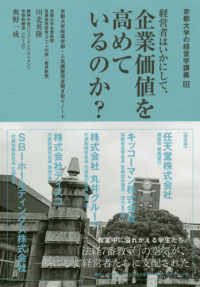Full Description
Glass is a material with essentially unlimited application possibilities. This second edition of a comprehensive reference in glass science, points out the correlation between the performance of industrial processes and practice-relevant properties, such as strength and optical properties. Interdisciplinary in his approach, the author discusses both the science and technology, starting with an outline of history and applications, glass structure, and rheology. The sections on properties include mechanical strength and contact resistance, ageing, mechanics of glass processes, the production and control of residual stresses, high-tech products, and current research and development. Applications include glazing, packaging, optical glass, glass fibers for reinforcement, and abrasive tools. The development of touchscreen technology showed how important were the design and resistance of thin flexible glass and these new thin aluminosilicate glasses are also discussed.
Contents
INTRODUCTION GLASS, A CERAMIC MATERIAL Four Classes of Materials Materials Properties Selecting Materials Performance Indexes Shape Factors in Mechanical Design GLASS PREHISTORY AND HISTORY Natural Glasses Early Glasses First Optical Glasses Modern Glasses for Insulation and Reinforcement Abrasive Tools Glass Manufacturers GLASS STRUCTURE Introduction Silica Glass and Related Glasses Borate Glass and Related Glasses Organic and Chalcogenide Glasses Metallic Glasses Avoiding Crystallization Vitroceramic Fabrication Surface Structure GLASS RHEOLOGY Viscosity Glass Transition and its Observation Viscous Response of Glass Visco-Elastic Response of Glass Thermal Tempering of Glass Transient Stress Chemical Tempering of Glass of Glass Stress Concentration and Griffith Energy Balance Linear Elasticity Crack Tip Stress Field SIF under Non-uniform Stress Toughness Measurement Influence of Residual Stress on Strength and Fragmentation Contact Sharp Contact Resistance Scratch Resistance Abrasion Resistance Introducing a Controlled and Critical Surface Flaw Cutting Glass Theory Life Time Under Static Fatigue Applications NiS Phase Introduction Float Process Fusion Draw Container Process Fiber Residual Stresses in Flat Glass Basics of Photoelasticity in Flat Glass Stress Meters HIGH-TECH PRODUCES AND R&D Market Trend-Driven R&D Flat Displays Thin-Film Technology Residual Stresses in Thin Film CONCLUSIONS APPENDICES Light Absorption and Dispersion Atomic Structure and Bond Formation Thermal Expansion and Elasticity Falling Sphere Viscometer and Fining of Glass Theoretical Strength of a Solid Weibull Analysis in Practice Photoelasticity Set Up for Lectures Instrumented Nanoindentation Applied to Thin Films Strain and Stress Flow and Plasticity in Glass Finite Element Analysis X-Ray Diffraction Analysis of Thin Film Residual Stresses Diffusion







